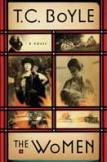Hating Frank
T. C. Boyle’s big, brilliant novel The Women tells the story of a larger-than-life man’s larger-than-life loves. This account of the architect Frank Lloyd Wright’s relationships with the women who devoted themselves to him in the course of his long life is the second novel in two years to depict Wright’s love affairs. Nancy Horan’s Loving Frank (2007) focused on the most sensational of his alliances, his five-year adulterous liaison with Martha “Mamah” Borthwick Cheney, which ended tragically in her brutal murder at the hands of a servant at Taliesin, the almost mythic rural retreat Wright built for her in Wisconsin.
Boyle’s novel is much more ambitious, as it attempts to chronicle four complex relationships with four radically different women: Catherine “Kitty” Tobin Wright, his wife of 20 years and mother to his six children, whom he leaves for Mamah Cheney; Mamah herself, a gifted intellectual inspired by the ideals of feminism and free love to leave her own marriage; Maude Miriam Noel, Wright’s second wife, a sculptor and Southern dilettante who is as vain as she is beautiful and cruel; and Olgivanna Lazovich Milanoff, the young Montenegrin dancer, his third wife, to whom he remains married until his death in 1959. These women have one thing in common: an unaccountable love for a singularly unlovable man. The unresolved mystery at the heart of this novel—a book that reads more like a tell-all memoir than a work of fiction—is why they fall so utterly, insanely and obsessively in love with a man the reader cannot stand.
To further emphasize Wright’s magnetism, Boyle assembles a galaxy of characters who are irresistibly drawn into his orbit. Among these is the novel’s fictional narrator, Tadashi Sato, a young Japanese architecture student apprenticed to Wright (whom he refers to deferentially as “Wrieto-San”). Along with a number of other apprentices, Tadashi lives at Taliesin from 1932 until 1941 as part of Wright’s household until the bombing of Pearl Harbor leads to his arrest and eventual internment in a prison camp in Northern California. Tadashi’s removal from Wright’s presence, rather than his imprisonment, causes him the deepest grief: “I didn’t care what became of me. I’d lost Taliesin. Lost Wrieto-San.” His devotion to his master is unwavering despite the fact that Wright does some rather despicable things to Tadashi, including breaking up his love affair with Daisy, one of the other architecture students, because he objects to miscegenation. In another instance, Wright the teetotaler unjustly accuses the ordinarily ascetic Tadashi of being an alcoholic because he takes some of the new apprentices to the local watering hole one night to celebrate their arrival.
Not only is Wright portrayed as a racist; he is a Puritan, and a hypocritical one at that, given the fact that he often takes the moral high ground even as he is violating his marriage vows and living openly as an adulterer. What to do with such a man? “Love him,” seems to be the answer. And love him they do—both men and women alike.
Yet their devotion does not prevent Tadashi or Wright’s wives and mistresses from acknowledging his faults. One of the most engaging aspects of the narrative is Tadashi’s tendency to editorialize, particularly in his introductions to each of the novel’s three parts and in his many footnotes. The latter sometimes serve as a species of savage marginalia in which he passes judgment on Wrieto-San, while at other times they bring to the foreground the minute and multitudinous ironies-within-ironies that characterize Wright’s life.
One arresting instance of this occurs in Part I as the narrator recounts, in thrilling detail, the fire that destroys Taliesin for the second time. Wright grieves as his magnificent home burns, a searing reminder of the first fire set years ago by the servant who killed Mamah and her children. The narrator questions whether the vengeful “God of Isaiah” was “striking at him again for his hubris, his too-perfect creation, the spark that made him godlike himself.” Within this grand, tragic context, the narrator poses an almost comical question in a parenthetical remark embedded in a footnote some pages later: “(And what is it with this man and fire?)” Indeed, the narrator nudges us, Wright’s life is haunted by conflagration, both literal and figurative, some deliberately set by Wrieto-San himself. The Promethean demigod is deflated even as the narrator looks on admiringly—and sympathetically.
This is a nervy thing for Boyle to do. The reader could easily be carried along on the sheer momentum of his exuberant storytelling as he recounts Catherine’s stalwart opposition, Mamah’s renunciation of respectability, Miriam’s mad obsession and Olgivanna’s poignant desire for security and stasis, but Boyle refuses to allow it. Tadashi’s interpolations detach and distance us from the story’s events in much the same way as the predatory press tantalized Wright’s contemporaries with reports of his marital upheavals and yet kept them at a voyeur’s safe remove. More is strangely less, and Wright remains a riddle.
Wright—and to a certain extent, his greatest creation, Taliesin—is the Rorschach test through which we come to understand each woman and what she sees in this troubled—and troubling—man. Yet, he serves as no passive object of contemplation. Rather, he figures as a potent force, a maker who relentlessly reshapes reality to suit his mastering vision, and his women figure among his works of art as surely as his buildings. As Catherine muses, “Everything was his. He’d put his stamp on inanimate things and people alike.” Though the novel may be titled The Women, let the reader make no mistake: it’s all about Frank.
This article also appeared in print, under the headline “Hating Frank,” in the March 23, 2009, issue.








